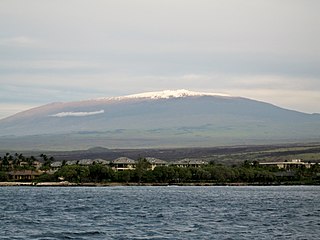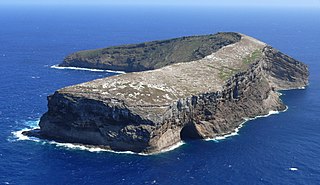
Kanmu Seamount is a seamount lying within the Hawaiian-Emperor seamount chain in the Pacific Ocean. The last eruption of Kanmu Seamount is unknown. [1]

Kanmu Seamount is a seamount lying within the Hawaiian-Emperor seamount chain in the Pacific Ocean. The last eruption of Kanmu Seamount is unknown. [1]

The Northwestern Hawaiian Islands or Leeward Hawaiian Islands are a series of islands and atolls in the Hawaiian island chain located northwest of the islands of Kauai and Niʻihau. Politically, they are all part of Honolulu County in the U.S. state of Hawaii, except Midway Atoll, which is a territory distinct from the State of Hawaii, and grouped as one of the United States Minor Outlying Islands. The United States Census Bureau defines this area, except Midway, as Census Tract 114.98 of Honolulu County. Its total land area is 3.1075 square miles (8.048 km2). All the islands except Nihoa are north of the Tropic of Cancer, making them the only islands in Hawaii that lie outside the tropics.

The Hawaiian–Emperor seamount chain is a mostly undersea mountain range in the Pacific Ocean that reaches above sea level in Hawaii. It is composed of the Hawaiian ridge, consisting of the islands of the Hawaiian chain northwest to Kure Atoll, and the Emperor Seamounts: together they form a vast underwater mountain region of islands and intervening seamounts, atolls, shallows, banks and reefs along a line trending southeast to northwest beneath the northern Pacific Ocean. The seamount chain, containing over 80 identified undersea volcanoes, stretches about 6,200 km (3,900 mi) from the Aleutian Trench off the coast of the Kamchatka peninsula in the far northwest Pacific to the Kamaʻehuakanaloa Seamount, the youngest volcano in the chain, which lies about 35 kilometres (22 mi) southeast of the Island of Hawaiʻi.

Kaʻula Island, also called Kaʻula Rock, is a small, crescent-shaped island in the Hawaiian Islands.

The fifteen volcanoes that make up the eight principal islands of Hawaii are the youngest in a chain of more than 129 volcanoes that stretch 5,800 kilometers (3,600 mi) across the North Pacific Ocean, called the Hawaiian–Emperor seamount chain. Hawaiʻi's volcanoes rise an average of 4,600 meters (15,000 ft) to reach sea level from their base. The largest, Mauna Loa, is 4,169 meters (13,678 ft) high. As shield volcanoes, they are built by accumulated lava flows, growing a few meters or feet at a time to form a broad and gently sloping shape.

In geology, hotspots are volcanic locales thought to be fed by underlying mantle that is anomalously hot compared with the surrounding mantle. Examples include the Hawaii, Iceland, and Yellowstone hotspots. A hotspot's position on the Earth's surface is independent of tectonic plate boundaries, and so hotspots may create a chain of volcanoes as the plates move above them.

The Hawaiian Lanternshark is a species of small squaliform shark in the family Etmopteridae.

Meiji Seamount, named after Emperor Meiji, the 122nd Emperor of Japan, is the oldest seamount in the Hawaiian-Emperor seamount chain, with an estimated age of 82 million years. It lies at the northernmost end of the chain, lies off the coast of the Kamchatka Peninsula, and is perched at the outer slope of the Kuril–Kamchatka Trench. Like the rest of the Emperor seamounts, it was formed by the Hawaii hotspot volcanism, grew to become an island, and has since subsided to below sea level, all while being carried first north and now northwest by the motion of the Pacific Plate. Meiji Seamount is thus an example of a particular type of seamount known as a guyot, and some publications refer to it as Meiji Guyot.

Detroit Seamount, which was formed around 76 million years ago, is one of the oldest seamounts of the Hawaiian-Emperor seamount chain. It lies near the northernmost end of the chain and is south of Aleutian Islands, at 51°28.80′N167°36′E

Koko Guyot is a 48.1-million-year-old guyot, a type of underwater volcano with a flat top, which lies near the southern end of the Emperor seamounts, about 200 km (124 mi) north of the "bend" in the volcanic Hawaiian-Emperor seamount chain. Pillow lava has been sampled on the north west flank of Koko Seamount, and the oldest dated lava is 40 million years old. Seismic studies indicate that it is built on a 9 km (6 mi) thick portion of the Pacific Plate. The oldest rock from the north side of Koko Seamount is dated at 52.6 and the south side of Koko at 50.4 million years ago. To the southeast of the bend is Kimmei Seamount at 47.9 million years ago and southeast of it, Daikakuji at 46.7.
Ōjin Seamount, also called Ōjin Guyot, named after Emperor Ōjin, 15th Emperor of Japan, is a guyot of the Hawaiian-Emperor seamount chain in the Pacific Ocean. It erupted 55 million years ago.

Nintoku Seamount or Nintoku Guyot is a seamount and guyot in the Hawaiian-Emperor seamount chain. It is a large, irregularly shaped volcano that last erupted 66 million years ago. Three lava flows have been sampled at Nintoku Seamount; the flows are almost all alkalic (subaerial) lava. It is 56.2 million years old.
Yomei Seamount is a seamount of the Hawaiian-Emperor seamount chain in the northern Pacific Ocean.

Yuryaku Seamount is a seamount and guyot (flat-topped) located northwest of Hawaii. It is located a little southwest of the V-shaped bend separating the Emperor Seamounts from the older Hawaiian islands, all of the Hawaiian-Emperor seamount chain in the North Pacific Ocean.
Kimmei Seamount is a seamount of the Hawaiian-Emperor seamount chain in the northern Pacific Ocean. It last erupted about 40 million years ago.
Jingū Seamount, also called Jingū Guyot, is a guyot of the Hawaiian-Emperor seamount chain in the Pacific Ocean. It erupted 55 million years ago. The seamount is elongated in structure, running north–south, and has an oval shaped crater in the center, which is evidence of collapse when above sea level.
Colahan Seamount is a seamount lying within the Hawaiian–Emperor seamount chain in the northern Pacific Ocean. It erupted 37–40 million years ago.
Abbott Seamount is a seamount lying within the Hawaiian-Emperor seamount chain in the northern Pacific Ocean. It erupted 36-40 million years ago.
Hancock Seamount is a seamount of the Hawaiian-Emperor seamount chain in the Pacific Ocean.

Arago hotspot is a hotspot in the Pacific Ocean, presently located below the Arago seamount close to the island of Rurutu, French Polynesia.
32°00′N173°10′E / 32.000°N 173.167°E